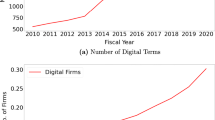Abstract
This paper examines the relation between firm risk and growth of Finnish firms. The results reveal a negative relation between risk (total and unsystematic risk) and firm investment. This negative relation is robust to the choice of estimation method. The results also suggest that labor-intensive firms respond to increased risk by substituting capital for labor. Discrete decision models reassure the main conclusions by showing that greater risk decreases (increases) the likelihood of simultaneous growth (decline) investment and employment.
Similar content being viewed by others
References
Abel, A.B. 1983. “Optimal Investment under Uncertainty.”American Economic Review 73: 228–233.
Amihud, Y., and B. Lev. 1981. “Risk Reduction as a Managerial Motive for Conglomerate Mergers.”Bell Journal of Economics 12: 605–617.
Appelbaum, E., and E. Katz. 1986. “Measures of Risk Aversion and Comparative Statics of Industry Equilibrium.”American Economic Review 76: 524–529.
Berger, P., and E. Ofek. 1995. “Diversification's Effect on Firm Value.”Journal of Financial Economics 37: 39–65.
Black, F. 1976. “Studies of Stock Price Volatility Changes.” Proceedings of the 1976 Meetings of the American Statistical Association, Business and Economics Statistics Section (American Statistical Association, DC): 177–181.
Bloom, N., S. Bond, and J. Van Reenen. 2001. “The Dynamics of Investment under Uncertainty.” Working paper, University College London and Institute for Fiscal Studies.
Bulan, L.T. 2001. “Real Options, Irreversible Investment and Firm Uncertainty: New Evidence from U.S. firms.” Working paper, Columbia University.
Cheung, Y.-W., and L.K. Ng. 1992. “Stock Price Dynamics and Firm Size: An Empirical Investigation.”Journal of Finance 47: 1985–1997.
Core, J.E., W. Guay, and D.F. Larcker. 2003. “Executive Equity Compensation and Incentives: A Survey.”FRBNY Economic Policy Review (April).
Comment, R., and G. Jarrell. 1995. “Corporate Focus and Stock Returns.”Journal of Financial Economics 37: 67–87.
Dixit, A., and R. Pindyck. 1994.Investment under Uncertainty. New Jersey: Princeton University Press.
Doornik, J.A., M. Arellano, and S. Bond. 2001. “Panel Data Estimation Using DPD for Ox.” Nuffield College, Oxford.
Duffie, G.R. 1995. “Stock Returns and Volatility: A Firm-Level Analysis.”Journal of Financial Economics 37: 399–420.
Fazzari, S., G. Hubbard, and B. Petersen. 1988. “Finance Constraints and Corporate Investment.”Brookings Papers on Economic Activity 1: 141–195.
Gertler, M., and S. Gilchrist. 1994. “Monetary Policy, Business Cycles, and the Behavior of Small Manufacturing Firms.”Quarterly Journal of Economics 108: 309–340.
Ghosal, V., and P. Loungani. 2000. “The Differential Impact of Uncertainty on Investment in Small and Large Businesses.”The Review of Economics and Statistics 82: 338–343.
Greenwald, B., and J. Stiglitz. 1990. “Macroeconomic Models with Equity and credit Rationing.” InAsymmetric Information, Corporate Finance, and Investment, edited by R. Hubbard. University of Chicago Press.
Greenwald, B., J. Stiglitz, and A. Weiss. 1984. “Informational Imperfections in the Capital Market and Macroeconomic Fluctuations.”American Economic Review 74: 194–199.
Hartman, R. 1972. “The Effects of Price and Cost Uncertainty on Investment.”Journal of Economic Theory 5: 258–266.
Hartman, R. 1976. “Factor Deman with Output Price Uncertainty.”American Economic Review 66: 675–681.
Henley, A., A. Carruth, and A. Dickerson. 2000. “Industry-Wide versus Idiosyncratic Uncertainty and Investment: British Company Panel Data Evidence.” Working paper, University of Wales Aberystwyth.
Hoshi, T., A. Kashyap, and D. Scharfstein. 1991. “Corporate Structure, Liquidity, and Investment: Evidence from Japanese Panel Data.”Quarterly Journal of Economics 106: 33–60.
Jensen, M.C. 1986. “Agency Costs of Free Cash Flow, Corporate Finance, and Takeovers.”American Economic Review 76: 323–329.
Jensen, M.C. 1993. “The Modern Industrial Revolution, Exit, and the Failure of Internal Control Systems.”Journal of Finance 48: 831–880.
Knif, J. 1988. “Tests for Market Model Instability, An Empirical Comparison of Tests using Recursive Residuals.” Research Reports 18, Swedish School of Economics and Business Administration, Helsinki.
Lang, L., and R.M. Stulz. 1994. “Tobin's Q, Corporate Diversification, and Firm Performance.”Journal of Political Economy 102: 1248–1280.
Lang, L., E. Ofek, and R.M. Stulz. 1996. “Leverga, Investment, and Firm Growth.”Journal of Financial Economics 40: 3–29.
Leahy, J., and T.M. Whited. 1996. “The Effect of Uncertainty on Investment: Some Stylized Facts.”Journal of Money, Credit and Banking 28: 64–83.
McDonald, R., and D. Siegel. 1986. “The Value of Waiting to Invest.”Quarterly Journal of Economics 101: 707–728.
Minton, B.A., and C. Schrand. 1999. “The Impact of Cash Flow Volatility on Discretionary Investment and the Costs of Debt and Equity Financing.”Journal of Financial Economics 54: 423–460.
Murphy, K. 1999. “Executive Compensation.” InHandbook of Labor Economics, edited by O. C. Ashenfelter and D. Card. Amsterdam: North-Holland.
Myers, S.C. 1977. “Interactions of Corporate Financing and Investment Decisions—Implications for Capital Budgeting.”Journal of Finance 29: 1–25.
Myers, S.C., and N.S. Majluf. 1984. “Corporate Financing and Investment Decisions When Firms Have Information That Investors Do Not Have.”Journal of Financial Economics 13: 187–221.
Pindyck, R. 1988. “Irreversible Investment, Capacity Choice, and the Valuation of the Firm.”American Economic Review 79: 969–985.
Schwert, G.W. 1989. “Why Does Stock Market Volatility Change over Time?”Journal of Finance 44: 1115–1153.
Shin, H-H., and R.M. Stulz. 2000a. “Shareholder Wealth and Firm Risk.” Working paper No. 2000-19, Ohio State University Dice Center.
Shin, H-H., and R.M. Stulz. 2000b. “Firm Value, Risk, and Growth Opportunities.” NBER working paper 7808 (July).
Stulz, R.M. 1999. “What's Wrong With Modern Capital Budgeting?” Financial Practice and Education working paper, Ohio State University Dice Center.
Author information
Authors and Affiliations
Corresponding author
Rights and permissions
About this article
Cite this article
Rosenberg, M.M. Firm risk, investment, and employment growth. J Econ Finan 28, 164–184 (2004). https://doi.org/10.1007/BF02761609
Issue Date:
DOI: https://doi.org/10.1007/BF02761609



